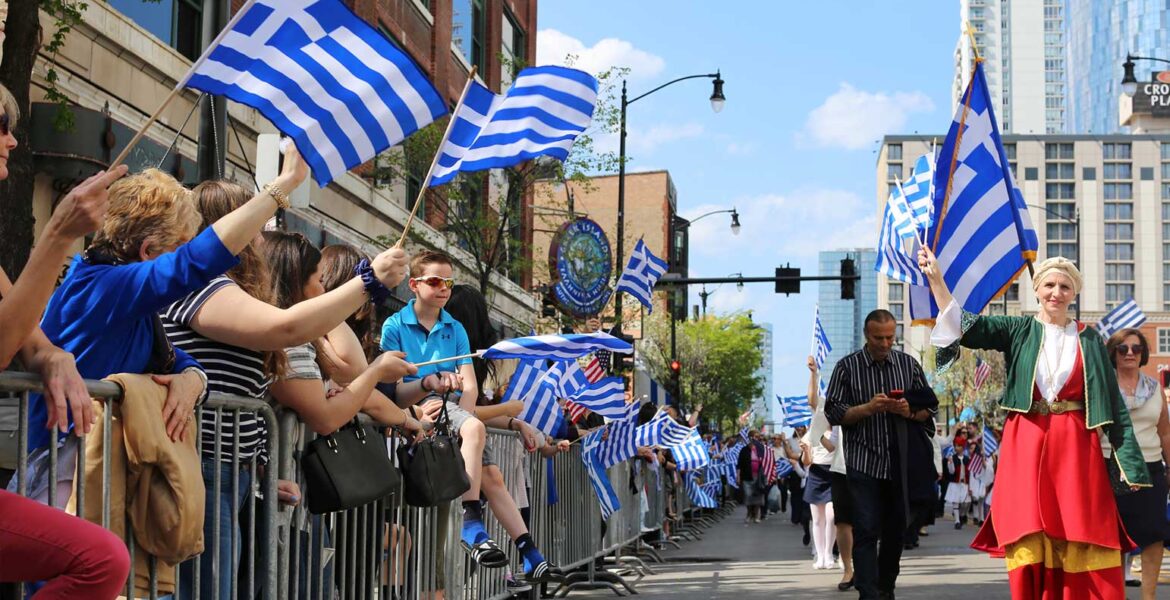The city of Chicago dressed in blue and white for its annual Greek heritage parade has returned to honour the 200 years since the Greek Declaration of Independence.
Hundreds of Greeks and philhellenes took to the streets on Sunday in Greektown to celebrate the Greek Heritage Parade, which is one of the biggest events in the Chicago Greek community reported CBS Chicago.
RESOURCE | ABOUT GREEKTOWN
Greektown is a general name for an ethnic enclave populated primarily by Greeks or people of Greek ancestry, usually in an urban neighborhood.
The oldest Greek dominated neighborhood outside of Greece were probably the Fener in Istanbul, or the Ash Shatibi in Alexandria.
In Vienna, for many centuries, the Griechenviertel (Greek quarter) existed in the Innere Stadt (inner town). Later the Greek community moved to other newer quarters. A traditional Austrian restaurant there is called Griechenbeisl (Greek tavern) and a street Griechengasse (Greek lane).
Greektown - Chicago
Greektown is a social and dining district, located on the Near West Side of the United States' city of Chicago, Illinois. Today, Greektown consists mostly of restaurants and businesses, although a cultural museum and an annual parade and festival still remain in the neighborhood.
The district can be found along Halsted Street, between Van Buren and Madison Streets.
The first Greek immigrants to settle in Chicago arrived in the 1840s via the Mississippi and Illinois rivers. The major fires of Chicago in 1871 caused significant further quantities of Greek immigrants to move to the area, inspired by the prospect of rebuilding the town of Chicago.
The original Greektown district on Halsted Street began with the Jane Addams Hull House, which acted as a meeting point for the Greek population within Chicago and provided a basis for community to be built from 1889. This house was used as a hub for the Greek community, and saw further small business expand within this area, despite small numbers, with 245 Greek people reported as living in Chicago, who were noted as predominantly young men of lower socio-economic background. This saw a slow expansion of restaurants, and various other stores throughout the century, with the Chicago Tribune reporting in 1895 that ‘the Greeks have almost run the Italians out of the fruit business in Chicago not only on a small retail way, but as wholesalers as well’.
Flaming Saganaki was invented at the Parthenon Restaurant in Chicago's Greektown.
Attempts to unite the various Greek restaurants in the area as well as the wider city were made with the establishment of "Hermes", a Greek business group in 1910. This group initially failed to gain traction amongst business owners. In the longer term, however, it unified the local Greek community, writing bylaws for its member businesses and organising social events, laying the framework for current regulatory bodies such as the Greektown organisation.
By 1930, the area which had become known as the "Greek Delta", held a foreign and native-born population of over 30,000. This population continued its growth and expansion with the district growing in size and area. This continued until 1960, when the opening of the University of Illinois Chicago campus, as well as the construction and opening of the Eisenhower Expressway, forced the neighborhood to move North along Halsted street to its current location along Halsted Street between Van Buren and Madison streets. The majority of functioning organisations and restaurants operating within the Greektown neighborhood opened within the 1970-1990 period following relocation to the current location along Halsted Street between Van Buren and Madison streets.
The onset of the COVID-19 pandemic in 2020 saw bars and restaurants within the precinct close for business and events either postponed or cancelled.


